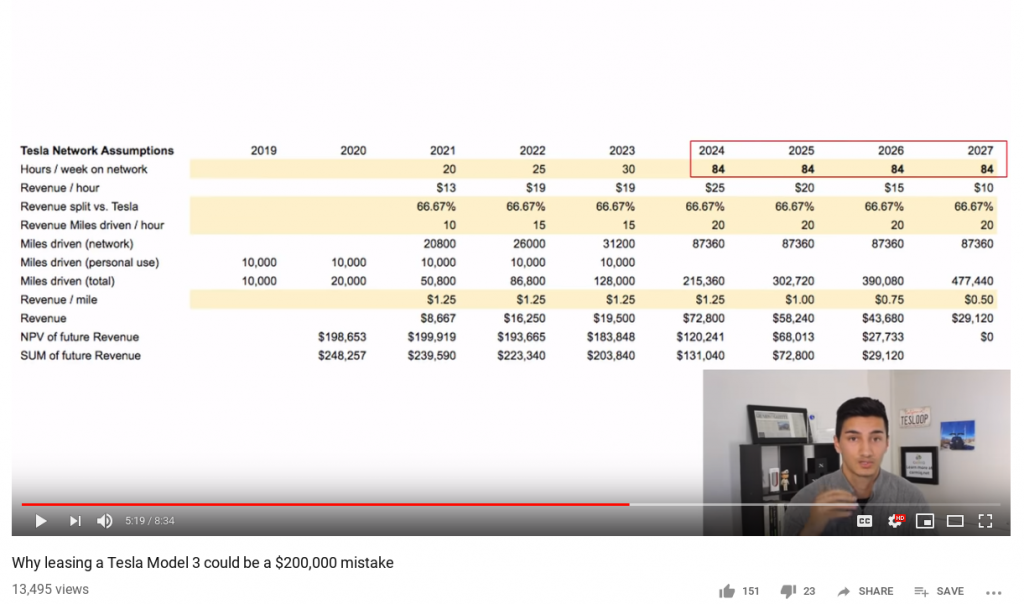Tesla Robo-Taxi Audit
May 17th, 20192 days ago, Inside EV's released the article Is Leasing A Tesla Model 3 A $200,000 Mistake?
This article comments on a video from the owner of Tesloop - Haydn Sonnad. Very few authorities hold a candle to Tesloop in this regard because Tesloop is a Tesla-centric taxi service having already operated many years and holds claims to some of the highest mileage Tesla vehicles I am aware of. Therefore, their numbers are way more interesting than mine so you should definitely checkout their video Why leasing a Tesla Model 3 could be a $200,000 mistake.
The conclusion reached is that if you hand the car back to Tesla, you are losing out on a massive monetary opportunity.

The image above looks at the financial opportunity one can leverage from allowing a Tesla vehicle to join Tesla's Robo-taxi fleet.
I will examine Haydn's numbers in an attempt to explore the upper bound of how much money per day/month/year one might be able to make from being a part of the Robo-taxi fleet.
Almost smack dab in the centre of this chart is the number of miles driven per year in 2024 (87,360). Is this possible/practical/realistic?
12 Hours/day is reasonable. It gives plenty of time to fully charge overnight at the cheapest electric rates (in Ontario $0.065/kW).
87,360/365 ~= 240 miles. This is the exact current capacity of the car. So these number operate on the assumption you will be using a single full charge.
With human driving, getting 240 miles out of the car is not realistic for me, but for a robot which will likely have energy efficiency built it, it will probably work in good conditions.
It is the best case logistically in that all miles are driven make $. It does not factor in miles needed to commute to the next patron.
Having said that, 240 miles can be achieved in many regards. The car can always be recharged/super charged and get back on the road.
I think 240 miles could definitely be practical with an owner that charges the car twice/day. It would be even easier to achieve with a long range Model 3.
Although these numbers look very optimistic, if the demand for the taxi's exist I don't see any reason why this would be unattainable. Even in cold weather conditions, an owner could likely do this with 3 charges/day.
Now let's focus on the $1.25 cost/mile. According to Ridester the average cost per mile for Uber and Lyft is $2/mile. So $1.25 is not only competitive, it is down right disruptive. Elon Musk has stated that cost/mile for a Tesla would be $0.18. And then if you factor in the 66% cut you get, you would get $0.11/mile.
I like that Haydn has used $1.25 because it dominates Uber which should keep demand high for the Robotaxi's and he also decreases this number by $0.25 each year factoring in elevated numbers of Model 3's competing in the fleet. Therefore I do think $1.25 is a reasonable number to start with.
In some ways Haydn's numbers are a best case scenario. It makes the assumptions that the cars drive 365 days of the year and fulfill 240 miles each day. With those numbers, one might be able to achieve $72,800/year.
But in terms of best case scenario, let's push the envelope in terms of practicality. We will keep the $1.25/mile cost and instead of doing 240 miles/day, we will do 200 mile trips and supercharge back to back.
A 200 mile trip at freeway speeds would take 3 hours. A supercharge back up to 90% will take 15 minutes on a V3 Supercharger. So every 3.25 hours, the car would earn $250. There are 8760 hours/year which would allow this cycle to occur 2695 times earning the vehicle $673,750/year. Assuming Tesla gives you 66% of the cut, that is $444,675/year for you and $229,075/year for Tesla.
Wow!
Posted In:
ABOUT THE AUTHOR:Software Developer always striving to be better. Learn from others' mistakes, learn by doing, fail fast, maximize productivity, and really think hard about good defaults. Computer developers have the power to add an entire infinite dimension with a single Int (or maybe BigInt). The least we can do with that power is be creative.
 The Limiting Factor
The Limiting Factor Whole Mars Catalog
Whole Mars Catalog